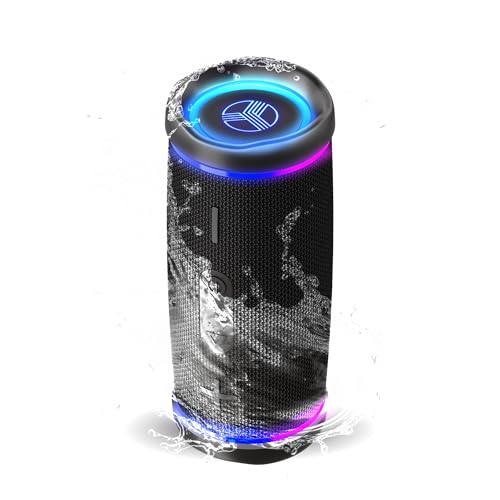When someone describes a Bluetooth speaker as boomy, it usually isn’t a compliment. Boomy sound is bass-heavy, yes — but not in a satisfying or controlled way. It’s the kind of low-end that overwhelms everything else, making music feel muddy, loose, or even tiring to listen to. Understanding what “boomy” really means helps you avoid speakers that mistake quantity for quality.
So, What Is “Boomy” Sound?
Boomy sound refers to exaggerated, uncontrolled bass, often in the 40Hz to 100Hz range. It tends to dominate the mix, spilling over into the mids and smearing detail across the board. A boomy speaker might impress at first — especially with hip-hop or dance music — but it quickly becomes fatiguing when that bass overwhelms vocals, instruments, or rhythm clarity.
Think of it this way:
If punchy bass is like a quick jab to the chest, boomy bass is like a heavy blanket thrown over the whole mix.
It’s loud, but it lacks definition.
Why Do People Dislike It?
Boomy bass sounds impressive in short bursts, but it can make everything else feel distant, muffled, or washed out. Vocals get buried, kick drums lose their edge, and melodies turn to mush. It’s especially problematic in small rooms, where standing waves can exaggerate the effect even further.
Listeners looking for clarity, tight rhythm, or natural vocal reproduction usually find boominess frustrating — especially when it can’t be fixed with EQ.
How Do You Recognize It?
Boomy speakers often sound powerful on first listen, but the lack of control becomes obvious over time. The bass lingers too long and bleeds into other frequencies, making everything feel bloated or slow.
Watch for these signs:
- Bass overwhelms vocals or other instruments
- Low-end feels slow or smeared, without attack
- Mids sound muffled or distant
- Listening fatigue — especially at medium-to-high volumes
- Poor definition in complex or layered tracks
What Causes Boomy Sound?
Boominess is often the result of poor speaker design or aggressive tuning. It can happen when manufacturers boost bass to impress casual listeners — especially in portable speakers that need to “feel” powerful. But without proper damping, driver control, or EQ balance, that boost just muddies everything else.
It often comes from:
- Overboosted sub-bass and low mids (30Hz–100Hz)
- Loose or underdamped speaker enclosures
- Slow transient response from low-quality drivers
- No EQ control to rein in the excess
Which Genres Suffer the Most?
While bass-heavy genres may seem like a natural match for boomy speakers, even hip-hop and EDM can sound bloated if the low-end lacks precision. Vocally driven genres or complex arrangements suffer the most — you lose all the nuance.
Genres most affected by boominess:
Even bass-focused genres like hip-hop benefit more from tight bass than boomy bass.
Bluetooth Speakers That Can Sound Boomy
Boominess tends to show up more in budget speakers or large party models where raw bass output is prioritized over control. That said, it’s not always a dealbreaker — some of these can be tamed with EQ or smart placement.
Big drivers and a rugged build make the D10 a volume beast, but its bass is often described as loose and bloated. Without EQ tweaking, it can easily overpower vocals and mask upper detail — especially indoors.
The Boombox 2 delivers huge low-end out of the box, but in its default tuning, it leans more toward rumble than rhythm. There’s a lot of weight, but not always the control you’d want for detailed tracks. EQ helps, but it’s still heavy-handed.
Portable and affordable, the HD77 brings the bass — but it can veer into boominess on certain tracks or when placed near walls. It’s fun for casual listening, but not for critical ears or complex genres.
Note: These boominess ratings are subjective and based on listening impressions, bass control, and tuning balance. Perception may vary depending on room acoustics, source material, and volume level.
How to Reduce Boominess (If You Can)
If your speaker has EQ control, there’s hope. You can pull the bass into shape with a few careful adjustments and better speaker placement.
Try this:
- Cut 40–80Hz slightly to reduce boom
- Boost a bit around 100–150Hz to recover punch
- Keep midrange clear — avoid cutting the mids too much
- Avoid placing the speaker near walls or corners (it amplifies bass)
Some speakers also benefit from resting on firmer surfaces, which reduces vibrations and low-end resonance.
Related Sound Characteristic: Punchy
Boomy and Punchy are often mistaken for one another, but they’re fundamentally different. Punchy bass is fast, controlled, and rhythm-driven. Boomy bass is loud, slow, and muddy. If your speaker feels like it has “too much” bass but not enough clarity or impact, odds are it’s boomy when what you really want is punch.
Final Thoughts
Boomy sound can feel impressive at first, but it rarely holds up over time. It’s the difference between hearing bass and feeling music. While some speakers can be tuned to tame the boom, others are stuck with it — and knowing what to listen for helps you steer clear. Look for control, not just output, and your music will thank you.
If you’ve ever described a speaker as sounding “muddy,” “bass-heavy,” or “a bit much,” boominess was likely the problem — now you know how to spot it.


